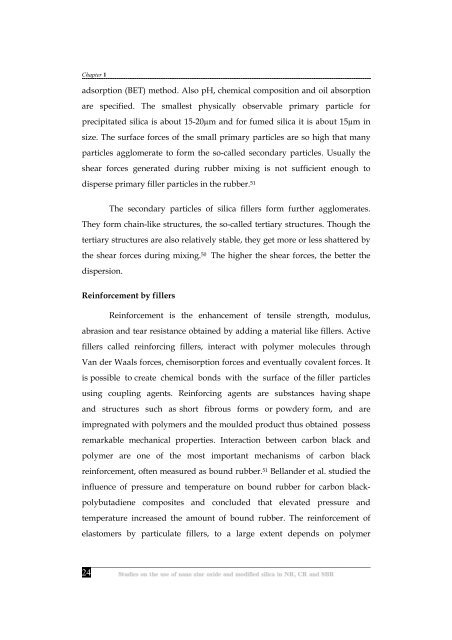Studies on the use of nano zinc oxide and modified silica in NR, CR ...
Studies on the use of nano zinc oxide and modified silica in NR, CR ...
Studies on the use of nano zinc oxide and modified silica in NR, CR ...
You also want an ePaper? Increase the reach of your titles
YUMPU automatically turns print PDFs into web optimized ePapers that Google loves.
Chapter 1<br />
adsorpti<strong>on</strong> (BET) method. Also pH, chemical compositi<strong>on</strong> <strong>and</strong> oil absorpti<strong>on</strong><br />
are specified. The smallest physically observable primary particle for<br />
precipitated <strong>silica</strong> is about 15-20µm <strong>and</strong> for fumed <strong>silica</strong> it is about 15µm <strong>in</strong><br />
size. The surface forces <strong>of</strong> <strong>the</strong> small primary particles are so high that many<br />
particles agglomerate to form <strong>the</strong> so-called sec<strong>on</strong>dary particles. Usually <strong>the</strong><br />
shear forces generated dur<strong>in</strong>g rubber mix<strong>in</strong>g is not sufficient enough to<br />
disperse primary filler particles <strong>in</strong> <strong>the</strong> rubber. 51<br />
24<br />
The sec<strong>on</strong>dary particles <strong>of</strong> <strong>silica</strong> fillers form fur<strong>the</strong>r agglomerates.<br />
They form cha<strong>in</strong>-like structures, <strong>the</strong> so-called tertiary structures. Though <strong>the</strong><br />
tertiary structures are also relatively stable, <strong>the</strong>y get more or less shattered by<br />
<strong>the</strong> shear forces dur<strong>in</strong>g mix<strong>in</strong>g. 50 The higher <strong>the</strong> shear forces, <strong>the</strong> better <strong>the</strong><br />
dispersi<strong>on</strong>.<br />
Re<strong>in</strong>forcement by fillers<br />
Re<strong>in</strong>forcement is <strong>the</strong> enhancement <strong>of</strong> tensile strength, modulus,<br />
abrasi<strong>on</strong> <strong>and</strong> tear resistance obta<strong>in</strong>ed by add<strong>in</strong>g a material like fillers. Active<br />
fillers called re<strong>in</strong>forc<strong>in</strong>g fillers, <strong>in</strong>teract with polymer molecules through<br />
Van der Waals forces, chemisorpti<strong>on</strong> forces <strong>and</strong> eventually covalent forces. It<br />
is possible to create chemical b<strong>on</strong>ds with <strong>the</strong> surface <strong>of</strong> <strong>the</strong> filler particles<br />
us<strong>in</strong>g coupl<strong>in</strong>g agents. Re<strong>in</strong>forc<strong>in</strong>g agents are substances hav<strong>in</strong>g shape<br />
<strong>and</strong> structures such as short fibrous forms or powdery form, <strong>and</strong> are<br />
impregnated with polymers <strong>and</strong> <strong>the</strong> moulded product thus obta<strong>in</strong>ed possess<br />
remarkable mechanical properties. Interacti<strong>on</strong> between carb<strong>on</strong> black <strong>and</strong><br />
polymer are <strong>on</strong>e <strong>of</strong> <strong>the</strong> most important mechanisms <strong>of</strong> carb<strong>on</strong> black<br />
re<strong>in</strong>forcement, <strong>of</strong>ten measured as bound rubber. 51 Bell<strong>and</strong>er et al. studied <strong>the</strong><br />
<strong>in</strong>fluence <strong>of</strong> pressure <strong>and</strong> temperature <strong>on</strong> bound rubber for carb<strong>on</strong> black-<br />
polybutadiene composites <strong>and</strong> c<strong>on</strong>cluded that elevated pressure <strong>and</strong><br />
temperature <strong>in</strong>creased <strong>the</strong> amount <strong>of</strong> bound rubber. The re<strong>in</strong>forcement <strong>of</strong><br />
elastomers by particulate fillers, to a large extent depends <strong>on</strong> polymer

















